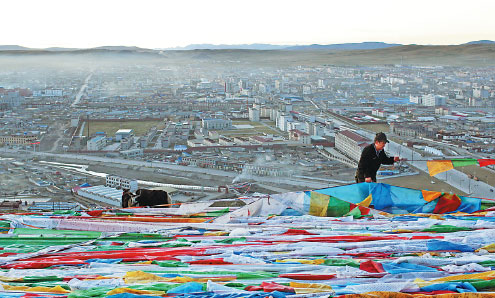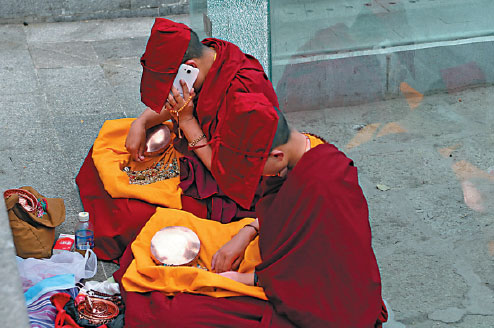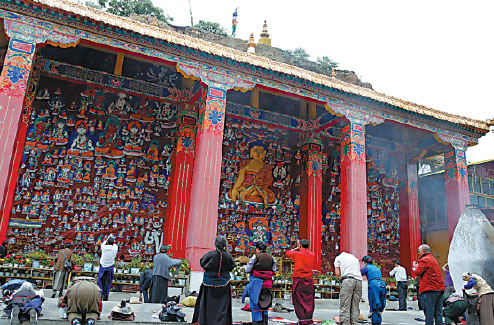Tech-savvy monks embrace new age
Updated: 2015-08-28 10:36
By Chen Bei and Luo Wangshu(China Daily USA)
|
|||||||||
Becoming a member of a Tibetan Buddhist order doesn't mean becoming totally divorced from the outside world, and today's devotees are using cellphones and tablets to stay in touch, report Chen Bei in Qamdo and Luo Wangshu in Xigaze in the Tibet autonomous region.
Editor's note: China is marking the 50th anniversary of the founding of the Tibet autonomous region. In the coming weeks, China Daily will bring you in-depth reports about developments in the region in the past half-century, focusing on culture and religion, environmental protection and eco-tourism.
If you spend 30 minutes checking Tenzin Yontan's social networking posts, you'll quickly get a good idea of his three main interests: Tibetan Buddhism; his family; and social engagement.
And if you've never met Tenzin, his posts will satisfy your curiosity because he occasionally posts "selfies", self-portraits that show a 20-something monk with chiseled features, dressed in a crimson robe.
Tenzin lives at the Champa Ling Monastery, the largest in the Gelugpa school of Buddhism in Qamdo, a city in the east of the Tibet autonomous region. The 27-year-old member of the Tibetan ethnic group said his daily routine revolves around listening to the teachings of the Buddha, analytical debates with fellow monks and reading the sutras.
It seems a world away from his peers in the outside world, yet Tenzin's smartphone reveals that monastic life is not totally divorced from modernity.
"Social media applications such as Weibo (a Twitter-like service) and WeChat (a popular Chinese social networking platform) are among the most used apps on my iPhone," he said, adding that he mainly uses social media to read the news, interact with friends and promote Buddhist culture.
Tenzin updates his WeChat "moments" about five or six times a month. He obviously adores his relatives who live several kilometers away, posting photos of his newborn niece and sending his best wishes to his parents on Father's Day and Mother's Day.
One of his latest updates contained prayers for those killed in a recent chemical explosion at a warehouse in the northern port city of Tianjin, China's worst industrial accident in decades.
Just a few hours after news of the initial death toll and the number of serious injuries began flooding China's social media networks, he posted: "Pay silent tribute to the dead, pray for the living and show respect for the courageous firefighters." The post was accompanied by a photo of a statue of the Buddha.
"Being a monk doesn't mean living in a sealed world, reading scriptures and praying for the release of dead souls from purgatory," Tenzin said. "A monk also needs to educate the living to do good works and help each other in this world. That means we have to know what's going on and communicate with society."
He said mobile gadgets such as smartphones and tablets help the younger generation of monks to keep their fingers on the pulse.
"With the help of social media, we can perform charitable works in a more effective way," he said, citing an instance in 2013 when he helped to raise 25,000 yuan ($3,900) in five days via WeChat to pay the medical bills of a 1-year-old called Losang Senge who had fractured his skull.
Tibet has a high rate of cellphone penetration and Internet usage. About 95 percent of the regional population is registered as cellphone users and by the end of July about 70 percent used the Internet regularly, according to the latest data from the regional development and reform commission.
The majority of Tibetans use smartphones, as indicated by a 2014 consumer-spending report by Alipay, the payment arm of e-commerce giant Alibaba Group Holdings, which showed that Tibetans accounted for the highest number of mobile payments - 62.2 percent - in the first 10 months of last year.
The Champa Ling Monastery is home to about 1,200 monks, and more than 700 of them own tablet computers and smartphones, including top brands such as Samsung, Huawei and Apple, according to Champa Kalzang, a 26-year-old monk.
Champa also uses WeChat, sharing his "moments" with friends. "I don't think mobile gadgets will distract me from Buddhist practises," he said, adding that he likes to "take things as they come".
"Social networking helps me keep up with the times, and I can also use it to promote Tibetan Buddhist culture because photos about rituals, religious stories and art are always given more 'likes'," he said. Champa downloads Buddhist scriptures onto his 11-centimeter-screen phone, which helps him to recite the sutras outside study periods.
The widespread use of electronic devices at the Champa Ling Monastery is not uncommon, according to Tenzin. "Most monks in Tibet's monasteries who were born after 1980 use mobile devices, although the senior are slow to adapt to such gadgets, "he said.
Located more than 1,200 km west of Qamdo, the Tashihunpo Monastery has adopted highly advanced technology to benefit visitors and pilgrims.

Since the beginning of this year, the traditional seat of the Panchen Lama in Xigaze, Tibet's second-largest city, has used a quick-response code system, under which the code is posted in front of every assembly hall.
Visitors can scan the QR code and select audio in three languages, Tibetan, Mandarin and English, and hear about the monastery's history on their cellphones.
"We invited some experts, including faculty members from Tibet University, to improve the quality of the translations," said Kachen Buchung, a high-ranking monk, who added that the system has proved a hit with visitors.
"When tour guides are in short supply, the audio instruction system is an alternative, free measure to fulfill visitors' needs," he said.
About 70 percent of the monastery's monks have smartphones and 20 percent own laptops, according to Kachen, who said many of them use electronic devices to read scriptures and learn Mandarin and even English.
"Many translation apps are fantastic. When we input something in Tibetan, the Mandarin translation just pops right out," he said.
Contact the writers at chenbei@chinadaily.com.cn and luowangshu@chinadaily.com.cn
|
A Tibetan man hangs colorful prayer flags in Ngaqu prefecture, Tibet. Wang Zhuangfei / China Daily |
|
A Tibetan monk makes a phone call in front of the Jokhang Temple in Lhasa. Wang Zhuangfei / China Daily |
|
Believers worship the Sakyamuni Buddha in Lhasa. Provided to China Daily |
(China Daily USA 08/28/2015 page10)

 Bolt 'somersaults' after cameraman takes him down
Bolt 'somersaults' after cameraman takes him down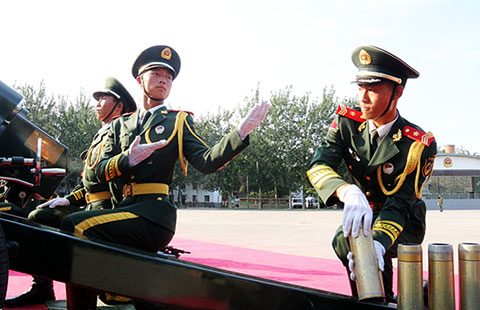
 A peek into daily drill of ceremonial artillery unit
A peek into daily drill of ceremonial artillery unit
 93-year-old's murals save Taiwan's 'Rainbow Village'
93-year-old's murals save Taiwan's 'Rainbow Village'
 Top 8 novel career choices in China
Top 8 novel career choices in China
 Hairdos steal the limelight at the Beijing World Championships
Hairdos steal the limelight at the Beijing World Championships
 Chorus of the PLA gears up for Sept 3 parade
Chorus of the PLA gears up for Sept 3 parade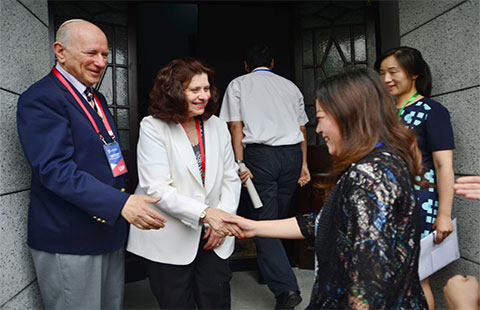
 Iconic Jewish cafe 'White Horse Coffee' reopens for business
Iconic Jewish cafe 'White Horse Coffee' reopens for business
 Beijing int'l book fair opens new page
Beijing int'l book fair opens new page
Most Viewed
Editor's Picks

|

|

|

|

|

|
Today's Top News
China eases rules for foreigners to buy property
Ministry denies troops sent to reinforce DPRK border
Stem cell donor offers ray of hope for US boy with leukemia
All creatures great and small help keep V-Day parade safe
China not the only reason global stock markets are in a tailspin
Market woes expected to delay Fed hike
Gunman had history of workplace issues
11 under probe and 12 detained over Tianjin blasts
US Weekly

|

|
